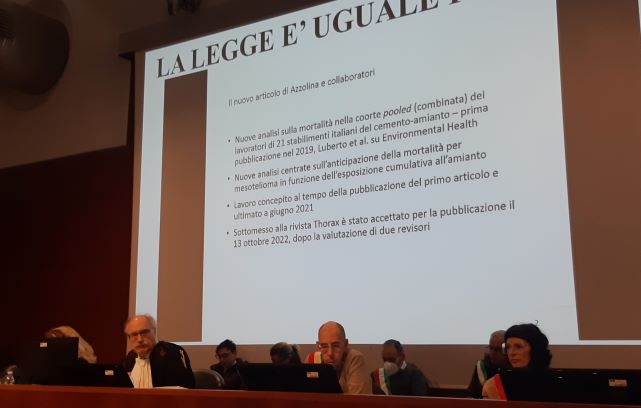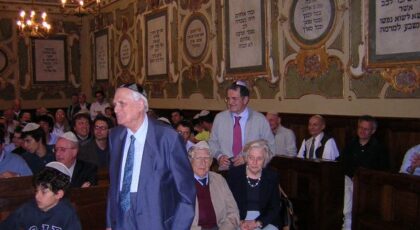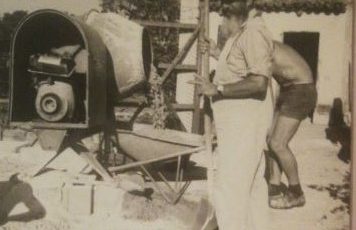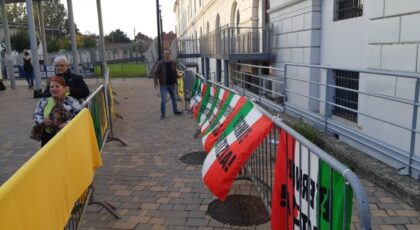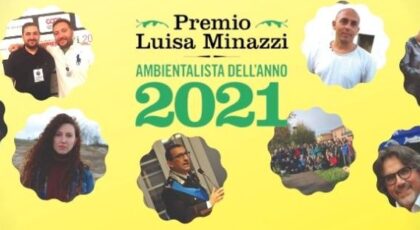SILVANA MOSSANO
Reportage udienza 16 gennaio 2023
«L’esposizione all’amianto causa il tumore polmonare e il mesotelioma, oltre al cancro alle ovaie e alla laringe e l’asbestosi. L’amianto è il cancerogeno di origine occupazionale più importante a livello mondiale, con circa 125 milioni di persone esposte all’amianto sul posto di lavoro». L’affermazione è contenuta nello «Studio Azzolina e altri», pubblicato a novembre 2022 sull’autorevole rivista scientifica Thorax e incentrato sulla «Misura dell’avanzamento del tasso di tumore al polmone e mesotelioma pleurico in lavoratori esposti all’amianto». Il lavoro, condotto sull’osservazione di 12578 lavoratori del cemento amianto in Italia, è stato oggetto di un animato confronto tra consulenti della procura e della difesa all’udienza di lunedì 16 gennaio del processo Eternit Bis, che si svolge in Corte d’Assise a Novara nei confronti dell’imputato Stephan Schmidheiny. L’imprenditore svizzero è accusato dell’omicidio volontario, con dolo eventuale, di 392 casalesi morti a causa del mesotelioma provocato all’amianto.
Prosegue il capoverso estratto dallo studio Azzolina et al: «Secondo le stime globali, almeno 107000 persone muoiono ogni anno per tumore ai polmoni asbesto correlato, per mesotelioma e asbestosi derivanti da esposizioni professionali. Il mesotelioma maligno è uno dei peggiori lasciti dell’esposizione all’amianto, con una stima di 27 mila decessi a livello mondiale nel 2017 (e qui si fa riferimento alle esposizioni professionali, ma poi ci sono le moltissime esposizioni ambientali che sappiamo quanti decessi abbiano causato e continuino a causare nel territorio di Casale Monferrato, ma non solo ndr)».
E ancora: «L’evidenza epidemiologica indica che la frequenza di cancro ai polmoni asbesto-correlato, mesotelioma e asbestosi aumenta con l’aumentare dell’esposizione cumulativa alle fibre».
Queste le premesse. Il risultato principale è che la mortalità è anticipata e lo è tanto più quanto maggiore è l’esposizione cumulativa. Confrontando i lavoratori con l’esposizione più alta e quelli con la più bassa a 40 anni di distanza dall’inizio delle loro esposizioni, è stata trovata un’anticipazione 26,6 anni per i tumori polmonari e di 33,8 per i mesoteliomi della pleura.
La conclusione è che «il presente studio» ha soprattutto «fornito per la prima volta stime quantitative dell’accelerazione temporale della mortalità per i tumori del polmone e della pleura con l’aumento dell’esposizione cumulativa all’amianto in ambito lavorativo».
E’ uno dei dilemmi più impegnativi che si troveranno ad affrontare i giudici della Corte d’Assise (presidente Gianfranco Pezone, a latere Manuela Massino più i sei popolari) quando dovranno esprimere una sentenza in merito alle contestate responsabilità dell’imprenditore svizzero in merito alle 392 vittime casalesi.
La domanda è: a una maggiore esposizione all’amianto corrisponde una anticipazione della comparsa del mesotelioma pleurico? Ovvero: rispetto ad una esposizione cumulativa «bassa», un aumento della esposizione cumulativa fa anticipare la morte per mesotelioma? (Precisiamo che l’esposizione cumulativa corrisponde alla somma di tutte le esposizioni di una persona durante la sua vita lavorativa).
Sì, è il parere convinto degli epidemiologi Corrado Magnani e Dario Mirabelli, consulenti dei pm Gianfranco Colace e Mariagiovanna Compare: l’evento morte, a fronte di una maggiore esposizione cumulativa all’amianto, viene anticipato, in base ai calcoli elaborati dallo studio Azzolina, da un minimo di 19 anni (per un’esposizione di livello intermedio, rispetto a quella più bassa) fino a 33 anni (per l’esposizione più alta, sempre rispetto alla più bassa). Ad esempio, consideriamo una persona fortemente esposta all’amianto a partire dall’età di 25 anni e deceduta a 65 per mesotelioma della pleura. Se anziché alla massima esposizione fosse stata esposta al più basso livello considerato nello Studio Azzolina, non avrebbe sviluppato il mesotelioma? Dal momento che avrebbe comunque ricevuto un’esposizione, avrebbe ancora potuto ammalarsi, ma solo 33 anni più tardi, cioè a 98 anni di età. Questa previsione, ovviamente, ha un valore di media, ottenuta studiando la mortalità in una popolazione. Ciò non significa che quella persona sarebbe sicuramente campata fino alla soglia del secolo di vita, perché ci sono altre cause alternative di morte (una diversa malattia, un infarto, un incidente… ad esempio); in questo caso, non si sarebbe neppure arrivati a una diagnosi di mesotelioma.
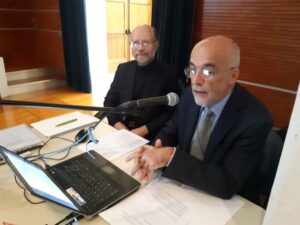
Magnani e Mirabelli avevano già mostrato gli indizi scientifici a sostegno della tesi dell’anticipazione in occasione dell’esame (29 novembre 2021) e del controesame (13 dicembre 2021). Lo Studio Azzolina et al è, a loro giudizio, una prova in più, un giudizio che, nel confronto processuale che ha impegnato l’intera giornata di lunedì, hanno argomentato e motivato con dati e grafici. Non ne avevano parlato nelle udienze in cui erano stati ascoltati, perché il lavoro non era ancora stato pubblicato.
Di parere ovviamente opposto il consulente della difesa Canzio Romano. Che dice: «Lo studio Azzolina non supera le conoscenze che già avevamo e cioè che a una maggiore esposizione alla fibra di amianto corrisponda un maggior tasso di incidenza». In altre parole: più aumenta l’esposizione all’amianto, più aumentano i casi di persone che si ammalano di mesotelioma. E fin qui… Quel che nega Romano è «che ci sia un’anticipazione» (cioè che queste persone si ammalino prima rispetto alla loro naturale aspettativa di vita, se non fossero state esposte). Il tono è provocatorio: «Non so come Magnani possa dimostrarlo, se me lo dimostra sono disposto a crederci».
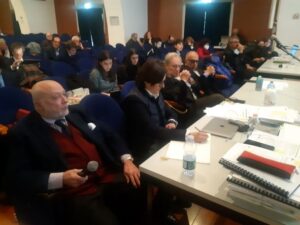
Secondo il professor Romano (e altri consulenti della difesa precedentemente esaminati), o a una maggiore esposizione alla fibra corrisponde un aumento dell’incidenza oppure c’è un accorciamento della latenza convenzionale (cioè il lasso di tempo compreso tra la prima esposizione e la morte): o è l’una o è l’altra.
Secondo i consulenti della procura Magnani e Mirabelli, invece, aumento e anticipazione dell’incidenza sono due facce della stessa medaglia: la stessa cosa misurata in due modi diversi.
Il consulente della difesa, poi, contrattacca su un altro resistente pilastro delle proprie tesi: insiste che il ruolo dell’epidemiologia consiste nell’osservare e analizzare il comportamento di gruppi di persone, in condizioni simili, ma i risultati ottenuti sarebbero dati medi e probabilistici; pertanto, questa scienza a suo parere non può essere ritenuta valida e non può essere applicata nei singoli casi.
Ma è quel che si fa sempre, è la replica degli scienziati Magnani e Mirabelli; ad esempio anche nella sperimentazione dei farmaci, facendo una comparazione tra un gruppo di malati cui viene somministrato un farmaco nuovo da testare e un altro gruppo cui viene somministrato un vecchio farmaco o un farmaco placebo. Se viene dimostrata, nel gruppo A, una maggior efficacia della nuova cura rispetto a quella vecchia somministrata al gruppo B, la terapia nuova viene poi adottata per i casi singoli.
Romano scuote la testa: «Io rimango della mia idea: l’epidemiologo ci dà informazioni sul gruppo e non sull’individuo». Parla di «valutazioni probabilistiche» e di «spannometria».
Alle accuse, già mosse in precedenti udienze, circa l’epidemiologia considerata come un coacervo di osservazioni su gruppi e popolazioni, i consulenti della procura hanno replicato: «L’epidemiologia si basa sull’osservazione e sull’analisi di casi concreti di singole persone che si sono ammalate». Inoltre, Magnani insiste e chiarisce: «Tutti gli studi hanno un margine di imprecisione, ma i lavori che abbiamo fatto li abbiamo condotti cercando di non avere errori sistematici (cioè causati da metodi di misura non corretti, ndr) che farebbero allontanare il rischio stimato dal rischio vero». Pertanto, «il dato medio ottenuto è una stima non distorta, e i risultati sono coerenti, ripetibili con analisi condotte in modo diverso».
Poiché il processo nei confronti di Schmidheiny si occupa di 392 specifici casi di omicidio, lo sforzo cui la difesa si dedica fin dall’inizio del processo non è tanto teso a portare e a dimostrare concrete tesi contrarie a quelle sostenute dalla procura, ma semplicemente minarle con i dubbi; in questo caso, mettere in dubbio che i risultati dei molteplici studi epidemiologici possano essere applicati per i singoli morti.
I CONSULENTI DELLE PARTI CIVILI
Il confronto disposto dal presidente della Corte Pezone ha coinvolto anche i consulenti della difesa Gino Barbieri ed Edoardo Bai.
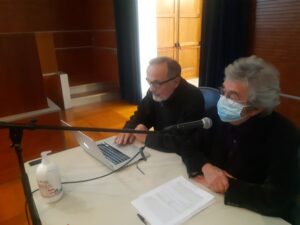
Barbieri ha tenuto a precisare un aspetto su cui era stato contestato dai consulenti della difesa riguardante «esposizioni ignote», cioè persone che si sono ammalate di mesotelioma e di cui inizialmente non si era riusciti ad accertare la fonte di esposizione all’amianto. «Le ricerche che si sono protratte negli anni hanno poi permesso di identificare le fonti consentendo di classificare i casi come “certamente” esposti e non “probabilmente”».
Nelle registrazioni dei mesoteliomi (come i ReNaM), tra le persone per le quali non si riesce a dimostrare una pregressa esposizione all’amianto è molto difficile distinguere tra “effettive non esposizioni”, “probabile assenza di esposizioni”, “inadeguata ricostruzione a posteriori della storia di esposizione” o “totale mancanza di dati”.
Ma senza esposizione all’amianto si svilupperebbe il mesotelioma? In un dibattito che si è svolto alla sede dell’Afeva di Casale, nell’ottobre dello scorso anno, l’epidemiologo italiano Benedetto Terracini (autore dei primi studi condotti a Casale) pose al medico del lavoro americano Arthur Frank proprio questa domanda e cioè se esistono mesoteliomi non legati all’amianto. E la risposta? Il professor Frank disse che, se mai questa possibilità esiste, è un’evenienza eccezionale.
Bai, invece, ha stigmatizzato il fatto che i consulenti di Schmidheiny hanno citato a sostegno delle loro tesi uno studio svolto nel 2012 dagli epidemiologi Carlo la Vecchia e Paolo Boffetta, su commissione della Montefibre e che era stato oggetto di accuse di conflitto di interessi. Bai ha ricordato che «La Vecchia e Boffetta avevano detto di aver condotto lo studio con il contributo dell’Airc (Associazione italiana per la ricerca sul cancro». Invece, «l’Airc stessa aveva immediatamente smentito, spiegando, tra l’altro, che Boffetta, che lavora all’estero, non aveva mai chiesto contributi all’Airc anche perché l’Associazione per statuto può finanziare soltanto ricercatori che lavorano in Italia».
CALENDARIO PER LA DISCUSSIONE
La fase dibattimentale del processo Eternit Bis avanti alla Corte d’Assise di Novara è praticamente terminata. Il presidente la chiuderà formalmente nell’udienza del 30 gennaio, per consentire alle parti la produzione degli ultimi documenti. Sono state poi concordate e fissate le date per la discussione. Eccole: lunedì 30 gennaio e venerdì 10 febbraio requisitore dei pubblici ministeri; lunedì 20 febbraio e lunedì 27 febbraio arringhe dei legali delle parti civili; venerdì 10 marzo e mercoledì 29 marzo arringhe dei difensori. La Corte fisserà, probabilmente tra fine aprile e maggio, un’ulteriore udienza per le repliche, prima di ritirarsi in camera di consiglio per decidere il verdetto.
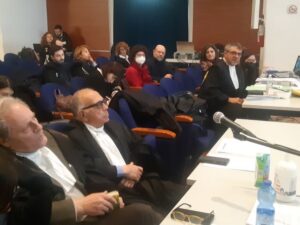
PROTESTE DEI GIUDICI POPOLARI
Tra i giudici popolari, una in modo particolare ha esternato segnali di disappunto, prima in aula poi nel corridoio al termine dell’udienza: «Dall’inizio di questo processo – ha detto contrariata – non abbiamo ancora percepito nessun compenso o rimborso spese. Abbiamo aspettato, ma adesso ci è stato detto che sono stati esauriti i soldi per il 2021! C’è chi non è di Novara, ma viene da altre località e ha anticipato le spese di viaggio oltre a sostenere disagi per contemperare i propri impegni lavorativi».
Il presidente della Corte d’Assise, Pezone, interpellato, ha precisato che la questione di carattere amministrativo-economico è di competenza della cancelleria della Corte d’Appello di Torino. In ogni caso, auspica che qualsiasi disservizio possa essere rapidamente chiarito e definito.
A seguire, i link degli articoli riferiti alle udienze in cui furono esaminati e controesaminati i consulenti Magnani, Mirabelli e Romano (e altri)
Mesotelioma, come si «insedia» il tumore dopo l’esposizione all’amianto
«Senza l’Eternit non ci sarebbero stati a Casale tutti quei mesoteliomi»
Eternit Bis: I medici casalesi hanno esagerato con le diagnosi di mesotelioma?
January the 16th Eternit Hearing
by Silvana Mossano
Translation by Victoria Franzinetti
” Asbestos exposure causes lung cancer and mesothelioma, as well as cancer of the ovary and the larynx and asbestosis. Asbestos is the most important occupational carcinogen worldwide with about 125 million people exposed to asbestos in the workplace.’ The statement is reported in the ‘Azzolina et al. article’, published in November 2022 in the authoritative journal Thorax and focuses on the ‘Rate advancement measurement of lung cancer and pleural mesothelioma rates in asbestos exposed workers’ using 12,578 asbestos cement workers in Italy. It was the subject of a lively exchange between prosecution and defense expert witnesses at the Monday 16 December hearing of the Eternit Bis trial, which is being held in the Novara Court of Assizes against the defendant Stephan Schmidheiny […].
Another quote from the Azzolina et al paper: ‘ According to global estimates, at least 107 000 people die each year from asbestos-related lung cancer, mesothelioma and asbestosis resulting from occupational exposures. Malignant mesothelioma is one of the worst legacies of asbestos exposure, causing an estimated figure of 27 000 deaths in the year 2017 worldwide. In this case we are referring to occupational exposures; environmental exposures have to be added such as the ones in the Casale Monferrato area. ‘ The epidemiological evidence indicates that the frequency of asbestos-related lung cancer, mesothelioma and asbestosis increases with increasing cumulative exposure to fibres’.
Such is the general picture. The main impact is that mortality rate is advanced and the more the higher the cumulative exposure – cumulative exposure corresponds to the sum of all exposures during a person’s working life and is measured as the product of concentration (number of fibres per millilitre of air, f/mL) and duration (in years); its unit of measure are, thus, fibre-years per millilitre, f-y/mL). Comparing workers with the highest and lowest exposure 40 years after first exposure, an anticipation of 26.6 years was observed for lung cancer and 33.8 for pleural mesothelioma.
The study offers quantitative estimates of the acceleration of mortality from lung and pleural cancers with increasing cumulative exposure to asbestos in the occupational setting for the first time.
The issue is one of the most challenging dilemmas that will face the judges of the Assize Court (Chief Justice Gianfranco Pezone, with judge Manuela Massino and the six members of the Jury, aka giudici popolari), when they will have to rule on the liability of the Swiss entrepreneur for the 392 victims of the Casale case.
The question is: does a greater exposure to asbestos simply increase the number of deaths, which is the effect commonly observed by employing standard methods of data analysis in epidemiological studies, or does it also lead (at the same time) to an earlier onset (advance) of pleural mesothelioma? That is, compared to a ‘low’ cumulative exposure, does an increase in cumulative exposure accelerate, anticipate death from mesothelioma?
This is the firm opinion expressed by epidemiologists Prof Corrado Magnani and Dr Dario Mirabelli, expert witnesses for the prosecutors Dr Gianfranco Colace and Dr Mariagiovanna Compare. The Azzolina study confirms that the higher cumulative exposure to asbestos the sooner mesothelioma deaths occur. As shown in Figure 1, panel B of the paper, for workers exposed to the intermediate category of asbestos exposure (54-620 f-y/mL) reaching a hazard of 0.00001 (corresponding to a death rate of 1 per 100.000 per year) requires an average latency of 37 years, whereas it takes only 32 years for those at the highest exposure level (above 620 f-y/mL). Other examples of disease or death advancement parallel to an increase of the relevant causal exposure can be found in the scientific literature, but this has been the first study to report on such findings for lung cancer and mesothelioma among asbestos workers.
Prof Magnani and Dr Mirabelli had already given the scientific evidence in support of the anticipation when previously examined on November the 29th, 2021, and cross-examined (13 December 2021). They had not mentioned the Azzolina study at the time, because the work had not yet been published.
The defense expert witness Prof Canzio Romano was of an obviously opposite opinion. He said: ‘The Azzolina study does not go beyond what we already knew, namely that greater exposure to asbestos fibre corresponds to a higher incidence rate. In other words: the greater the exposure to asbestos, the greater the number of people falling ill with mesothelioma. What Prof Romano denies is ‘that there is an anticipation’ (i.e. that these people with high exposure develop the illness sooner than those with low exposure, thus further curtailing their life expectancy they would have had if they had not been exposed). The tone is provocative: ‘I don’t know how Prof Magnani can prove it, if he proves it to me I am willing to believe it’.
According to Professor Romano (and other previously examined defense expert witnesses), either greater exposure to fibres corresponds to an increase in incidence or there is a shortening of the expected latency (i.e. the time lapse between first exposure and death): it is either one or the other.
According to the prosecution expert witnesses Prof Magnani and Dr Mirabelli, increase and anticipation of incidence are two sides of the same coin: the same thing measured in two different ways.
The defense expert witness answered another of his theses: he insists that the role of epidemiology is to observe and analyze the behavior of groups of people, under similar conditions, but the results obtained would be average and probabilistic data; therefore, he believes this type of science cannot be considered valid and cannot be applied to individual cases.
However, Prof Magnani and Dr Mirabelli pointed out this is what is always done: for instance in drug trials, comparisons are made between a group of patients given a new drug to be tested and another group given the standard treatment or a placebo. If the new treatment is shown to be more effective in group A than the old one given to group B, the new treatment is then adopted and, of course, administered to individual cases. Prof Romano disagreed: ‘I stand by my idea: epidemiology gives us information about a group, not an individual’. He speaks of ‘probabilistic assessments’ and rule of thumb.
The prosecution expert witnesses replied to these accusations about epidemiology being regarded as a patchwork of observations on groups and populations, already made in previous hearings: ”Epidemiology is based on the observation and analysis of actual cases of individuals who have developed the disease’. Moreover, Prof Magnani insisted: ‘All studies have a margin of inaccuracy, but the work we have done was carried out in an attempt to avoid systematic errors (i.e. caused by incorrect measurement methods) that would cause the estimated risk to deviate from the actual risk’. Therefore, ‘the average figure obtained is an unbiased estimate, and the results are consistent, repeatable with analyses conducted with different methods’.
Since the trial against Schmidheiny concerns 392 specific cases of murder, since the beginning the effort the defense has been to raise doubts rather than being aimed at proving something which challenges the Prosecutors. In this case, questioning whether the results of the multiple epidemiological studies can be applied to individual deaths.
PLAINTIFF’S EXPERT WITNESSES
President Pezone also questioned the plaintiffs’ expert witnesses Dr Gino Barbieri and Dr Edoardo Bai.
Dr Barbieri was keen to clarify and point out that he had been questioned by the defense concerning ‘unknown exposures’, i.e. people who developed mesothelioma and whose exposure to asbestos could not initially be ascertained. “Research over the years then made it possible to identify the sources, so that now we can classify cases as ‘certainly’ exposed and not ‘probably’“.
In mesothelioma records (such as the Mesothelioma National Registry ReNaMs), it is very difficult to distinguish between ‘actual non-exposure’, ‘probable absence of exposure’, ‘inadequate retrospective reconstruction of exposure history’ or ‘total lack of data’ among persons for whom no previous exposure to asbestos can be demonstrated.
The question is whether mesothelioma would develop without asbestos exposure? In a debate held at the Afeva headquarters in Casale, in October last year, the Italian epidemiologist Prof Benedetto Terracini (author of the first studies conducted in Casale) asked the American occupational physician Dr Arthur Frank precisely this question, namely whether non asbestos related mesotheliomas exist. Professor Frank said that, if such a possibility exists, it would be an exceptional occurrence.
Dr Bai criticized the fact that Schmidheiny’s consultants cited in support of their thesis a study carried out in 2012 by epidemiologists Carlo la Vecchia and Paolo Boffetta. The study content and conclusions matched those of the expert testimony they had given for the defense of former managers of [the chemical company] Montefibre and had been accused of conflict of interest. Dr Bai recalled that ‘La Vecchia and Boffetta had stated they had conducted the study with the contribution of AIRC (Italian Association for Cancer Research) but ‘AIRC itself had immediately denied this, explaining, among other things, that Prof Boffetta, who works abroad, had never applied AIRC for contributions, also because the association, by statute, can only fund researchers working in Italy’.
NEXT HEARINGS
This part of the Eternit Bis trial before the Novara Assize Court is practically over. The Chief Judge will formally close it in the hearing of January the 30th , to allow the parties to produce the last documents. Dates for the discussion were then agreed and fixed.
Monday, January the 30th and Friday, February the 10th the PPs’ closing speeches; Monday, the 20th of February and, February the 17th , arguments by the plaintiffs’ lawyers; Friday, March the 10th and Wednesday, March the 29th, closing arguments by the defense. The court will schedule a further hearing, probably between the end of April and May, for replies, before withdrawing into chamber and then will announce their verdict.
THE JURY MEMBERS PROTESTS
The jury members, and one in particular voiced their disappointment, first in the courtroom then in the corridor at the end of the hearing: ‘Since the beginning of this trial we have not yet received any compensation or refund of expenses. We have waited, but now we have been told that there is no more money for 2021 [nor for later] ! Those of us who are not from Novara, but come from other places and have covered travel expenses as well as suffering inconveniences to balance their work commitments have not received anything’.
When questioned, the Chief of the Assize Court, Dr Pezone, clarified that the administrative-economic issue is a matter for the Turin Court of Appeal. In any case, he hopes that any inefficiency can be quickly clarified and defined.
«Le esposizioni più elevate all’amianto accorciano la vita anche di oltre trent’anni»
the Italian version linked above includes photos

